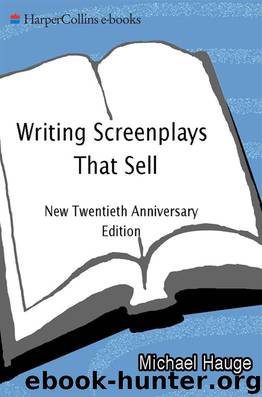Writing Screenplays That Sell, New Twentieth Anniversary Edition: The Complete Guide to Turning Story Concepts into Movie and Television Deals by Michael Hauge

Author:Michael Hauge
Language: eng
Format: mobi
Publisher: HarperCollins
Published: 2013-04-29T14:00:00+00:00
CHARTING THE SCREENPLAY
For a truly left-brained exercise, chart your screenplay scene by scene. Wait until you’ve done at least a couple drafts of your script before employing this device, because if you get this organized too soon in the process, you run the risk of eliminating all spontaneity from your screenplay. Charting is more effective when you’ve exhausted the brain-storming possibilities of your story and feel too close to your writing to come up with anything new. The chart can then give you a new perspective to stimulate creativity.
First, number the scenes in your screenplay. (This is for your own use; don’t number the scenes in the final draft for submission.) Then, using index cards, sheets of paper, your computer, or large sheets of newsprint, make the following chart, creating a column for each scene in your script.
Begin filling out the chart by putting the appropriate page number after each scene number at the top of the page. For example, if scene 19 begins on page 54 of your script, the top of that column should read: 19 (54).
Download
This site does not store any files on its server. We only index and link to content provided by other sites. Please contact the content providers to delete copyright contents if any and email us, we'll remove relevant links or contents immediately.
Asking the Right Questions: A Guide to Critical Thinking by M. Neil Browne & Stuart M. Keeley(5645)
Autoboyography by Christina Lauren(5184)
Eat That Frog! by Brian Tracy(4436)
Dialogue by Robert McKee(4323)
Sticky Fingers by Joe Hagan(4103)
Journeys Out of the Body by Robert Monroe(3572)
Annapurna by Maurice Herzog(3424)
Full Circle by Michael Palin(3389)
Schaum's Quick Guide to Writing Great Short Stories by Margaret Lucke(3319)
Elements of Style 2017 by Richard De A'Morelli(3307)
The Art of Dramatic Writing: Its Basis in the Creative Interpretation of Human Motives by Egri Lajos(3017)
Atlas Obscura by Joshua Foer(2899)
The Diviners by Libba Bray(2887)
In Patagonia by Bruce Chatwin(2876)
Why I Write by George Orwell(2875)
The Fight by Norman Mailer(2848)
The Mental Game of Writing: How to Overcome Obstacles, Stay Creative and Productive, and Free Your Mind for Success by James Scott Bell(2845)
Venice by Jan Morris(2526)
The Elements of Style by William Strunk and E. B. White(2442)
